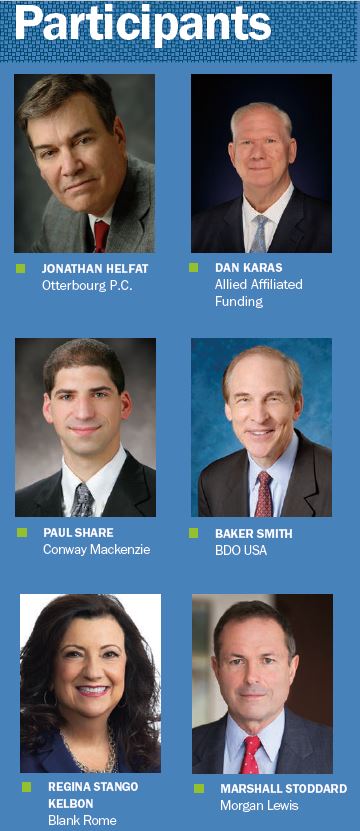Assessing The Bankruptcy Environment: The Experts Weigh In
By Myra Thomas
The Federal Paycheck Protection Program loan funds did buy many struggling businesses time to weather the proverbial economic storm. Plus, secured lenders, not surprisingly, found it much more advantageous to work with borrowers and extend liquidity than deal with a bankrupt business. The idea was simply that the pandemic couldn’t last forever and that the economy, as it is now, does appear to be on the mend.
Asset-based lenders were aware of the problems going into the pandemic. Not surprisingly, brick and mortar retailers, already facing significant financial stress before the shutdown, did take the brunt of the pandemic and many were forced to shutter stores, says Dan Karas, executive vice president of Allied Affiliated Funding, a division of Axiom Bank, N.A. Many large retailer liquidations dominated 2020, including J.C. Penney and Pier 1. The silver lining for lenders, as it turns out, is that liquidations were generally not the order of the day for most businesses, he adds. According to data from Epiq, commercial Chapter 11 filings grew year-over-year, up 29% in 2020 compared to 2019.
Ready to Respond
Secured lenders were more than ready to deal with an increase in Chapter 11 fi lings. “Banks geared up and doubled and tripled their workout groups,” says Karas. “I’ve found that banks were encouraged to identify problems early.” Rounds of PPP money from the federal government provided more liquidity than expected. Additionally, secured lenders were and remain more amenable to amending terms to help borrowers stem the proverbial tide against the lingering effects of the pandemic.
According to Karas, 2021 is likely to hold much of the same with less liquidations and more restructuring situations for borrowers in industries hardest hit during the pandemic. The expectation too is that the market for DIP financing will continue to grow, in return. Karas does express some concern about the value of collateral in these situations, given the lingering impact of COVID-19. “I am still optimistic,” he adds, noting that many borrowers and the economy in general have bounced back more and quicker than expected.
A Better Understanding of Bankruptcy
For those companies needing to restructure, Chapter 11 is a business vehicle and not necessarily a sign of insecurity. Today, says Jonathan Helfat, partner at Otterbourg, P.C., the strategy is often used by businesses seeking a sale scenario or a reorganization. “Just because a company seeks relief under Chapter 11 doesn’t mean the world comes to an end,” he notes. “Lenders and lawyers understand that, but the public often does not.” Even with the increase in Chapter 11 fi lings in 2020 and the pandemic, secured lenders fared well.
The bankruptcy courts were also much more lenient when it came to how they handled fi lings in 2020. “Some courts made the decision early on in the pandemic to hold off creditors from taking actions in some jurisdictions,” says Helfat. “What was interesting was that some of the bankruptcy judges in certain jurisdictions were willing to give the debtors a holding period to catch their breaths.” The bankruptcy judges sometimes extended deadlines, but not every jurisdiction. “We saw Chapter 11 filings where landlords wanted their Chapter 11 rent paid and judges held off these landlords,” he added.

Monitoring the Situation
With the concern about restructurings ever present, the smart lenders continue to have more people on the ground than ever. “The main question for asset-based lenders will be whether their particular portfolios will recover post-Covid and whether they should continue to wait, amend, and extend their credit facilities, and ride out the turmoil until the particular industry gets back to normal, with the hope that with the return to normalcy, recoveries will be maximized,” says Regina Stango Kelbon, partner and head of Blank Rome’s bankruptcy practice. Certainly, the hardest hit industries were predictable, including retail, energy, hospitality, theaters, restaurants, and airlines. Commercial real estate will also continue to be impacted, Kelbon notes, given the ripple effect of the many shuttered retail locations across the country. For the hardest hit sectors, the stress of having to shutter operations due to the pandemic could just mean more liquidations down the road for some.
While the pandemic plays out through the economy, the realization of the cost of a bankruptcy filing may be the one thing to make restructuring a much better option for borrowers. “There have been a number of restructurings underway, such as Bed, Bath and Beyond selling off non-core units like the Christmas Tree Shops and trying to focus on their e-commerce platform or Macy’s obtaining additional liquidity through its credit facilities while planning to close more than a hundred stores.” Kelbon agrees with Karas’s assessment that, for the lender, it will continue to be a question of how much patience to have for some of their borrowers who were the hardest hit by the pandemic. “There’s no magic,” she adds. “There are many different solutions.” The impact and effective rollout of the U.S. vaccination program against COVID-19 will hopefully mean that Americans will quickly get back to the stores, theaters, and restaurants and serve to boost the economy and borrowers in turn.
Setting the Tone
Government support, whether to businesses or consumers, played a large part in forestalling bankruptcy filings in 2020 up to now and will do much of the same in 2021. According to Marshall Stoddard, partner, transactional finance, at Morgan Lewis, this is still one of the big unknowns in the long term. “Government support on the commercial side has probably reached its end point,” he notes. “If the government focuses on consumer rehabilitation, that was the big variable in 2020 that kept many companies afloat and prevented a more serious recession.”
With every administration change, there is always some uncertainty. President Biden has signaled that he will be much more consumer-oriented than the prior administration. “A period of stabilization, I think, is coming and that’s good for secured lenders,” says Stoddard. Uncertainty causes, in some respects, knee jerk reactions or a more conservative stance. “I see a leveling out and lenders will be able to manage credits without as much of a macro focus.”
The Takeaway
Secured lenders are still remaining smart, strengthening underwriting, tightening eligibility requirements for collateral, and requiring enhanced monitoring in deeper workout scenarios. Given the cost, time, and drama of any type of bankruptcy, the steps to file need to be considered carefully. But Paul Share, managing director at Conway MacKenzie, does offer one warning. “There’s enough cash slushing around right now that the cracks got papered over and the U.S. took the debt onto their books,” he says. Stimulus cash did enable the weaker companies to live for another day. What happens next is anyone’s guess.
For companies where bankruptcy is inevitable, Share says that it isn’t always the easiest exit. “Lenders have to evaluate the benefits and look for additional sources of protection, such as guarantees by equity sponsors or additional documentation upfront.” Since COVID-19, secured lenders are also noting increased negotiations over MAE clauses in M&A transactions. There’s also quite a bit of push and pull on the intercreditor agreement side between senior and junior lenders.
According to Baker Smith, managing director, BDO USA LLP, the proactive clients take the initiative to come up with workout plans. Even if the workout takes time, secured lenders appear to be much happier to deal with the borrower in this situation and to keep them in the portfolio. “Lenders spend a ton of time and money to add each client and they will simply not tolerate runoff for those coming up with a realistic plan,” he adds. With secured lenders more than a year into the pandemic, they have learned how to better evaluate run rates and get more comfortable with proforma projections, given the new normal.
What Secured Lenders Need
However, Smith notes that secured lenders need to realize that a filing will not have the desired effect without having a good advisory team in place. While the borrower picks the professionals, the question is always just how much influence a lender has on the decision. “The company needs to turn to the lenders for the funds to execute the bankruptcy, so the lender can share their recommendations and opinions for the best financial advisors and attorneys,” notes Smith. This is the kind of advice that is frequently discussed prior to the commitment to funding.
One favorable development when it comes to bankruptcy filings is that there is a push to move the process along much quicker than it might have gone in the 2008 recession. “Several years ago, when companies got relief from creditors and were operating normally, there was no major push to get out of bankruptcy,” Smith notes. “Today, when the bankruptcy is filed, everyone gets the picture that it needs to move along promptly. Professionals have a sense of urgency to avoid spending too much money and not dissipate the collateral.” Smith predicts that this will continue throughout 2021. He adds that most bankruptcy court hearings and depositions in bankruptcy cases take place virtually. Courts have much better systems in place, becoming more sophisticated about the process of getting all of the parties together and having them take the oath needed to testify.
In wind-down sales, secured lenders need a timetable with milestones in place to monitor and full access to the investment banker. It’s essential to keep on top of the situation, Smith says, making sure due diligence is started, site visits are happening, and asset purchase agreement is in place. “If nothing’s happening, the collateral is typically deteriorating as a function of time,” he adds. “If it’s a going-concern sale, it will stumble and stagger across the finish line without the proper lender financing and the various professionals that keep the wheels of progress going, whether it’s the lender, attorneys or investment banker.” That’s why a timetable and access are essential.
Looking Ahead
Despite the past year, secured lenders are still pointing favorably to 2021 and are not predicting considerable liquidations ahead. Certain industries, Stoddard argues, are simply critical to the economy. “The airlines, for example, are going to be around,” he notes. “The economy needs the airline industry. They will survive, may restructure, and may get more government assistance, but they can’t be replaced.” The retailers that still exist have mostly or completely figured out how to stay in business and appeal to the consumer, he notes. While secured lenders will likely see some hotel liquidations and sales, the entire industry can’t be replaced.
Stoddard predicts a leveling off of bankruptcies. “Lenders are going to make more traditional credit decisions in 2021 and will be able to look to inventory values reaching a level of stability,” he says. Inventory values and receivable collections all suffered during the pandemic. 2021 appears to be more predictable, so secured lenders can make effective credit decisions and look at individual companies again. The consensus seems to be that, if a client has made it this far, they probably have staying power.


